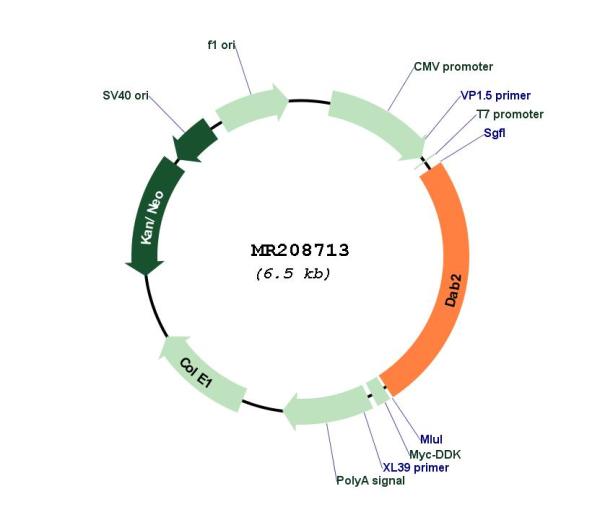Dab2 (NM_001008702) Mouse Tagged ORF Clone
CAT#: MR208713
- TrueORF®
Dab2 (Myc-DDK-tagged) - Mouse disabled homolog 2 (Drosophila) (Dab2), transcript variant 2
ORF Plasmid: tGFP
"NM_001008702" in other vectors (3)
Need custom modification / cloning service?
Get a free quote
CNY 4,088.00
CNY 4,560.00
CNY 300.00
Specifications
| Product Data | |
| Type | Mouse Tagged ORF Clone |
| Tag | Myc-DDK |
| Synonyms | 5730435J12Rik; AA960054; AI957090; D15Wsu122e; D630005B22Rik; Doc-2; Doc2; p96 |
| Vector | pCMV6-Entry |
| E. coli Selection | Kanamycin (25 ug/mL) |
| Mammalian Cell Selection | Neomycin |
| Sequence Data |
>MR208713 ORF sequence
Red=Cloning site Blue=ORF Green=Tags(s) TTTTGTAATACGACTCACTATAGGGCGGCCGGGAATTCGTCGACTGGATCCGGTACCGAGGAGATCTGCC GCCGCGATCGCC ATGTCTAACGAAGTAGAAACAAGCACAGCCAATGGTCAGCCTGACCAACAGGCTGCCCCGAAAGCACCAT CAAAGAAGGAGAAGAAGAAAGGTTCTGAAAAGACAGACGAGTACTTGTTGGCCAGGTTCAAAGGTGATGG TGTAAAATACAAGGCCAAGCTAATCGGTATTGATGATGTGCCTGATGCTCGAGGAGACAAAATGAGCCAG GATTCTATGATGAAACTCAAGGGAATGGCAGCAGCTGGTCGCTCTCAGGGACAACACAAGCAAAGAATCT GGGTCAACATTTCCTTGTCTGGCATAAAAATCATTGATGAGAAAACTGGGGTAATTGAACATGAACATCC AGTAAATAAGATTTCCTTCATTGCTCGTGATGTGACAGACAACAGAGCATTTGGTTATGTGTGTGGAGGT GAAGGCCAGCATCAATTTTTTGCTATAAAAACAGGGCAACAGGCTGAACCATTAGTCGTCGATCTTAAAG ACCTTTTTCAAGTTATCTATAATGTAAAGAAAAAGGAAGAAGATAAGAAAAAGGTTGAAGAAGCCAACAA AGCAGAAGAGAATGGAAGTGAGGCCCTAATGACCCTTGATGATCAAGCTAACAAATTGAAGCTGGGTGTT GACCAGATGGATTTGTTTGGGGACATGTCTACACCTCCTGGCCTAAATAGTCCAACATCTTCAGCAAACG ACTTGCTTGCTTCAGACATCTTTGCCTCAGAACCTCCAGGCCAGATGTCCCCCACAGGACAACCTGCAGT CCCGCAGTCGAACTTTCTGGATCTCTTCAAAGGCAATGCTCCTGCCCCAGTGGGGCCCCTTGTAGGTCTA GGTACGGTCCCAGTAACACCCCCCCAAGCAGGACCCTGGACGCCTGTTGTCTACAGTCCTTCGACAACTG TGGTCCCAGGAGCCATAATAAGTGGCCAGCCTCCCAGTTTTGGCCAGCCACTCGTTTTTGGTACAACCCC AGCAGTACAAGTCTGGAATCAGCCTCCATCATTTGCAACCCCAGCTTCCCCTCCACCCCCCACAGTTTGG TGTCCTACCACATCTGTGGCGCCCAACGCTTGGTCATCCACAAGCCCTCTGGGGAATCCTTTTCAGAGTA ATAATATCTTTCCACCTCCCACCATGTCCACTCAGTCCTCTCCTCAGCCTATGATGTCCTCTGTTCTGGC CACACCGCCTCAACCACCTCCCCGAAATGGCCCACTAAAGGACATTCCCAGTGACGCTTTCACTGGCTTA GACCCCCTTGGGGATAAAGAGGTCAAAGAAGTGAAAGAAATGTTTAAGGACTTCCAGCTGCGGCAGCCAC CTCTTGTTCCCTCAAGGAAGGGGGAGACGCCTCCCTCTGGGACTTCAAGCGCCTTCTCCAGTTACTTCAA CAATAAAGTTGGCATTCCTCAGGAGCACGTAGACCATGATGATTTTGATGCCAATCAACTGTTGAACAAG ATTAATGAACCACCAAAGCCAGCCCCGAGACAAGGTGTCCTCTTGGGTACCAAGTCTGCTGACAATTCAC TTGAGAACCCTTTCTCCAAAGGGTTCAGCTCATCAAACCCCTCTGTGGTTTCTCAGCCTGCATCTTCTGA TCCCCACAGGAGCCCTTTCGGAAATCCTTTTGCC ACGCGTACGCGGCCGCTCGAGCAGAAACTCATCTCAGAAGAGGATCTGGCAGCAAATGATATCCTGGATT ACAAGGATGACGACGATAAGGTTTAA >MR208713 protein sequence
Red=Cloning site Green=Tags(s) MSNEVETSTANGQPDQQAAPKAPSKKEKKKGSEKTDEYLLARFKGDGVKYKAKLIGIDDVPDARGDKMSQ DSMMKLKGMAAAGRSQGQHKQRIWVNISLSGIKIIDEKTGVIEHEHPVNKISFIARDVTDNRAFGYVCGG EGQHQFFAIKTGQQAEPLVVDLKDLFQVIYNVKKKEEDKKKVEEANKAEENGSEALMTLDDQANKLKLGV DQMDLFGDMSTPPGLNSPTSSANDLLASDIFASEPPGQMSPTGQPAVPQSNFLDLFKGNAPAPVGPLVGL GTVPVTPPQAGPWTPVVYSPSTTVVPGAIISGQPPSFGQPLVFGTTPAVQVWNQPPSFATPASPPPPTVW CPTTSVAPNAWSSTSPLGNPFQSNNIFPPPTMSTQSSPQPMMSSVLATPPQPPPRNGPLKDIPSDAFTGL DPLGDKEVKEVKEMFKDFQLRQPPLVPSRKGETPPSGTSSAFSSYFNNKVGIPQEHVDHDDFDANQLLNK INEPPKPAPRQGVLLGTKSADNSLENPFSKGFSSSNPSVVSQPASSDPHRSPFGNPFA TRTRPLEQKLISEEDLAANDILDYKDDDDKV |
| Restriction Sites |
SgfI-MluI
Cloning Scheme for this gene
Plasmid Map

|
| ACCN | NM_001008702 |
| ORF Size | 1647 bp |
| OTI Disclaimer | The molecular sequence of this clone aligns with the gene accession number as a point of reference only. However, individual transcript sequences of the same gene can differ through naturally occurring variations (e.g. polymorphisms), each with its own valid existence. This clone is substantially in agreement with the reference, but a complete review of all prevailing variants is recommended prior to use. More info |
| OTI Annotation | This clone was engineered to express the complete ORF with an expression tag. Expression varies depending on the nature of the gene. |
| Product Components | The ORF clone is ion-exchange column purified and shipped in a 2D barcoded Matrix tube containing 10ug of transfection-ready, dried plasmid DNA (reconstitute with 100 ul of water). |
| Reconstitution | 1. Centrifuge at 5,000xg for 5min. 2. Carefully open the tube and add 100ul of sterile water to dissolve the DNA. 3. Close the tube and incubate for 10 minutes at room temperature. 4. Briefly vortex the tube and then do a quick spin (less than 5000xg) to concentrate the liquid at the bottom. 5. Store the suspended plasmid at -20°C. The DNA is stable for at least one year from date of shipping when stored at -20°C. |
| Reference Data | |
| RefSeq | NM_001008702.1, NM_001008702.2, NP_001008702.1 |
| RefSeq Size | 3792 bp |
| RefSeq ORF | 1647 bp |
| Locus ID | 13132 |
| UniProt ID | P98078 |
| MW | 58.6 kDa |
| Gene Summary | Adapter protein that functions as clathrin-associated sorting protein (CLASP) required for clathrin-mediated endocytosis of selected cargo proteins. Can bind and assemble clathrin, and binds simultaneously to phosphatidylinositol 4,5-bisphosphate (PtdIns(4,5)P2) and cargos containing non-phosphorylated NPXY internalization motifs, such as the LDL receptor, to recruit them to clathrin-coated pits. Can function in clathrin-mediated endocytosis independently of the AP-2 complex. Involved in endocytosis of integrin beta-1; this function seems to redundant with the AP-2 complex and seems to require DAB2 binding to endocytosis accessory EH domain-containing proteins such as EPS15, EPS15L1 and ITSN1. Involved in endocytosis of cystic fibrosis transmembrane conductance regulator/CFTR. Isoform p96 is involved in endocytosis of megalin/LRP2 lipoprotein receptor during embryonal development. Required for recycling of the TGF-beta receptor. Isoform p67 is not involved in LDL receptor endocytosis. Involved in CFTR trafficking to the late endosome. Involved in several receptor-mediated signaling pathways. Involved in TGF-beta receptor signaling and facilitates phosphorylation of the signal transducer SMAD2. Mediates TFG-beta-stimulated JNK activation. May inhibit the canoniocal Wnt/beta-catenin signaling pathway by stabilizing the beta-catenin destruction complex through a competing association with axin preventing its dephosphorylation through protein phosphatase 1 (PP1). Sequesters LRP6 towards clathrin-mediated endocytosis, leading to inhibition of Wnt/beta-catenin signaling. May activate non-canonical Wnt signaling. In cell surface growth factor/Ras signaling pathways proposed to inhibit ERK activation by interrupting the binding of GRB2 to SOS1 and to inhibit SRC by preventing its activating phosphorylation at 'Tyr-419'. Proposed to be involved in modulation of androgen receptor (AR) signaling mediated by SRC activation; seems to compete with AR for interaction with SRC. Plays a role in the CSF-1 signal transduction pathway. Plays a role in cellular differentiation. Involved in cell positioning and formation of visceral endoderm (VE) during embryogenesis and proposed to be required in the VE to respond to Nodal signaling coming from the epiblast. Required for the epithelial to mesenchymal transition, a process necessary for proper embryonic development. May be involved in myeloid cell differentiation and can induce macrophage adhesion and spreading. Isoform p67 may be involved in transcriptional regulation. May act as a tumor suppressor.[UniProtKB/Swiss-Prot Function] |
Documents
| Product Manuals |
| FAQs |
| SDS |
Resources
Other Versions
| SKU | Description | Size | Price |
|---|---|---|---|
| MG208713 | Dab2 (tGFP-tagged) - Mouse disabled homolog 2 (Drosophila) (Dab2), transcript variant 2 |
CNY 5,040.00 |
|
| MR208713L3 | Lenti ORF clone of Dab2 (Myc-DDK-tagged) - Mouse disabled homolog 2 (Drosophila) (Dab2), transcript variant 2 |
CNY 6,460.00 |
|
| MR208713L4 | Lenti ORF clone of Dab2 (mGFP-tagged) - Mouse disabled homolog 2 (Drosophila) (Dab2), transcript variant 2 |
CNY 6,460.00 |


 United States
United States
 Germany
Germany
 Japan
Japan
 United Kingdom
United Kingdom
 China
China

